In our fast-paced, digitally-driven world, finding moments of calm and inner peace can feel like an impossible task. That’s why meditation music apps like Calm and Headspace have become oases of tranquility for millions worldwide, guiding users towards stress reduction, better sleep, and improved mental well-being.
The demand for such apps is skyrocketing. As of 2023, the global meditation app market is estimated at $1.49 billion and is projected to grow at a compound annual growth rate (CAGR) of 18.2% from 2024 to 2030. Leading apps like Calm boast over 100 million downloads, while Headspace has surpassed 80 million downloads, a testament to the immense popularity and reach of these platforms.
If you’re inspired to create your own meditation app, you’re tapping into a market with tremendous potential. Even with a limited budget, it’s entirely possible to develop a successful app. This comprehensive guide is designed for those who have a brilliant idea for a meditation app but are working with a limited budget. We’ll explore every step of the process, from defining your app’s unique appeal to smart development and marketing strategies, all with a focus on cost-effectiveness.
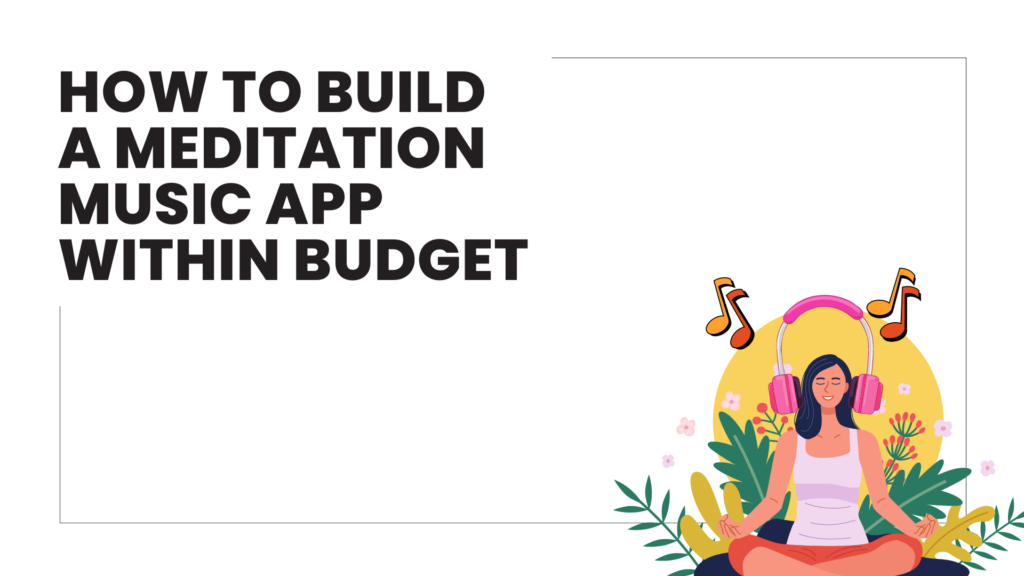
Craft Your Unique Value Proposition (UVP)
Your UVP is the heart and soul of your app. It answers the question: “Why should someone choose my app over all the others?” A compelling UVP will make your app stand out in a crowded market and attract your ideal users.
- Niche Focus: Are you targeting a specific demographic (e.g., students, athletes, new parents)? Do you specialize in a particular meditation style (e.g., mindfulness, transcendental meditation, yoga nidra)?
- Unique Content: Do you offer unique guided meditations, stories, music, or soundscapes that can’t be found elsewhere?
- Special Features: Do you have innovative features like personalized recommendations, community forums, or AI-powered coaching?
By clearly defining your UVP, you’ll be able to differentiate your app and attract your ideal users.
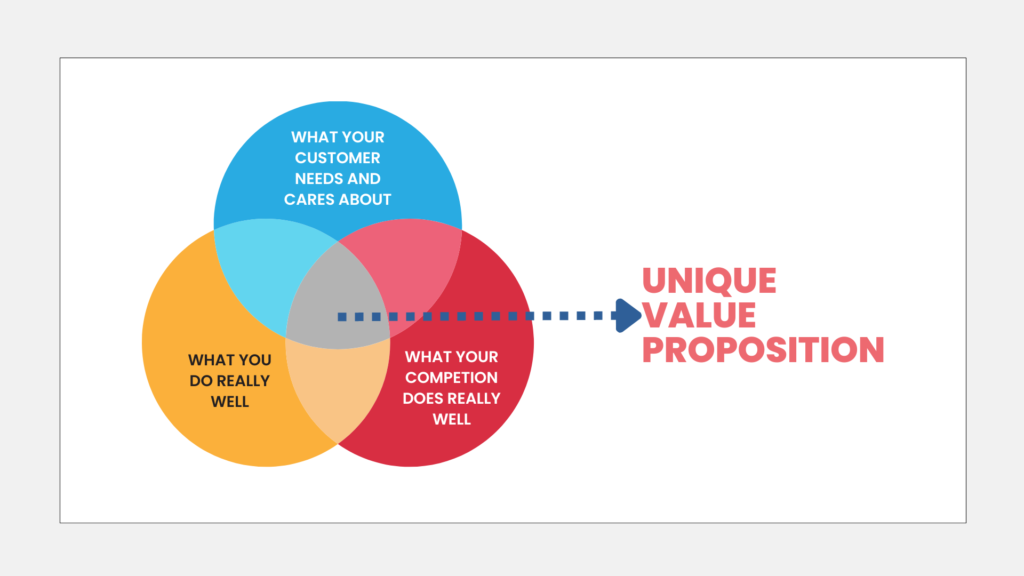
Examples of UVPs of top meditation music apps
- Calm: “The #1 app for sleep, meditation, and relaxation.” This UVP emphasizes Calm’s broad appeal and its focus on multiple aspects of well-being.
- Headspace: “Meditation and mindfulness made simple.” Headspace positions itself as a beginner-friendly app that makes meditation accessible and easy to understand.
- Waking Up: “The app that teaches you how to meditate.” Waking Up focuses on education and offers a structured curriculum to guide users through the fundamentals of meditation.
- Insight Timer: “The largest free library of guided meditations.” Insight Timer differentiates itself by offering a vast amount of free content from a diverse range of teachers and traditions.
- Aura: “Personalized mindfulness for stress & anxiety.” Aura uses AI to personalize recommendations based on the user’s mood, needs, and preferences.
Essential Features for a Successful Meditation Music App
While Calm and Headspace boast a plethora of features, you don’t need to replicate everything at once. Start with the essentials that deliver your UVP:
- Guided Meditations: A diverse library of meditations varying in length, topic, and style. Consider themes like stress relief, sleep improvement, anxiety management, focus enhancement, and self-compassion.
- Meditation Timer: For users who prefer unguided practice, a customizable timer with options for interval bells and ambient sounds is crucial.
- Soundscapes and Music: Curate a collection of calming sounds and music to enhance the meditation experience. Think nature sounds, instrumental music, binaural beats, or white noise.
- Progress Tracking: Help users visualize their meditation journey with statistics on total time meditated, streaks, and milestones achieved. This can be a powerful motivator.
- Additional Features (Optional): Once your core features are solid, consider adding things like sleep stories, educational content, community forums, or personalized recommendations.
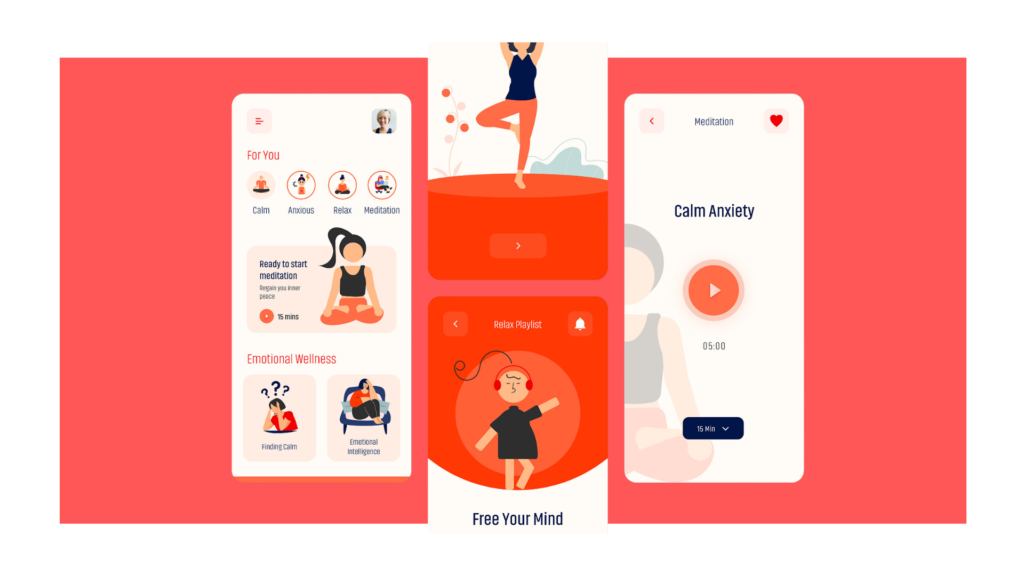
Smart Design Choices
The design of your app is crucial for creating a calming and inviting atmosphere:
- Intuitive UI/UX: Make sure your app is easy to navigate and use, even for those who are new to meditation. A cluttered or confusing interface can be a major turnoff.
- Soothing Visuals: Opt for a calming color palette (e.g., pastels, earth tones) and minimal design elements. Avoid harsh colors or busy patterns that could be distracting.
- High-Quality Audio: Invest in professional voiceovers for your guided meditations and ensure that all sounds and music are clear and high-quality. Poor audio can ruin the meditation experience.
Streamline Design with UI Templates
To save time and resources, consider leveraging existing UI templates available on platforms like Figma or Envato Elements. These templates provide a solid foundation of well-designed screens, layouts, and components, allowing you to focus on customization and branding rather than starting from scratch.
Case Study: Wolfpack’s Design-Driven Transformation of the Chakra Balance App
Mishi’s Chakra Balance app had a wealth of information and features, but its cluttered interface and disjointed user experience were hindering its full potential. Users struggled to navigate the app and fully engage with the chakra-balancing tools it offered.
Wolfpack stepped in with a design-focused intervention. Leveraging Flutter’s flexibility and a deep understanding of user experience, we transformed the app into a visually stunning and intuitive digital sanctuary. By consolidating elements onto a single screen and implementing seamless background downloads, we made it effortless for users to explore their chakras and access the resources they needed. This design-driven transformation led to increased user engagement, positive reviews, and a more impactful chakra-balancing experience.
Learn more about the Chakra Balance app’s design-driven transformation in our detailed case study.
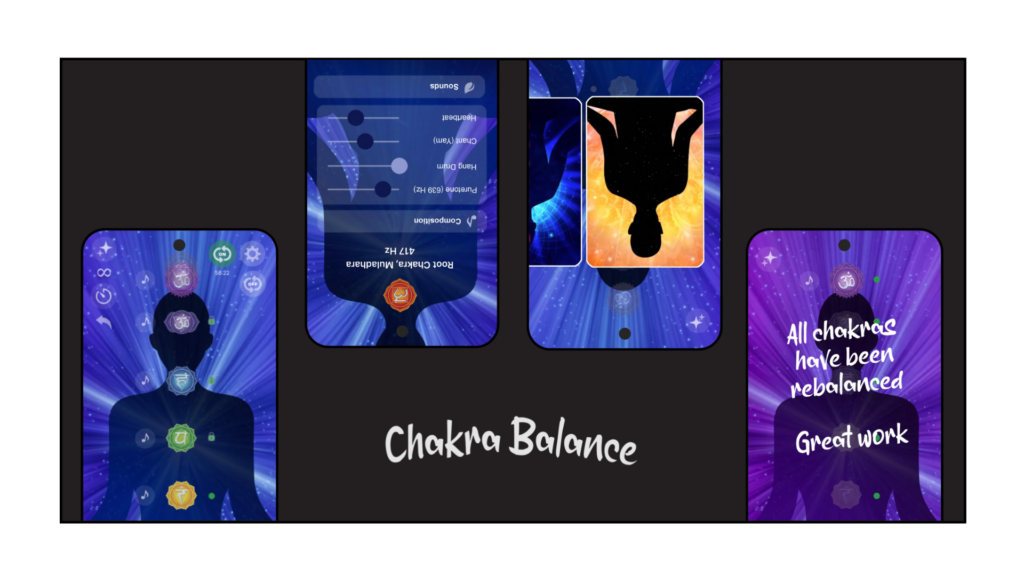
Cost-Effective Tech Stack for Your Meditation App
- Cross-platform Development: Frameworks like Flutter or React Native allow you to build your app for iOS and Android simultaneously, significantly cutting down development time and costs.
- Backend-as-a-Service (BaaS): Leverage platforms like Firebase or Supabase to handle your backend needs. This eliminates the need to build your own backend infrastructure, saving you both time and money.
- Firebase: Offers real-time databases, user authentication, cloud storage, push notifications, and more.
- Supabase: An open-source alternative to Firebase, providing similar features with increased flexibility.
- Open-Source Libraries: Utilize pre-built components for features like audio playback, progress tracking, and user interface elements. This can save you from having to build everything from scratch.
For example, if you are building your app on Flutter, you may use the plugin just_audio, a feature-rich audio player which supports a wide range of audio formats and provides features like looping, speed control, and background playback.
Building Your Meditation App Team on a Budget
Assembling the right development team is crucial for creating a successful meditation app within your budget. Consider these two approaches for cost-effective talent acquisition:
Freelancers
Freelancers can be a great option for specific tasks or augmenting your existing team. They typically charge lower hourly rates than agencies and offer a high degree of flexibility. You can find talented freelancers on platforms like Upwork, Fiverr, or Guru.
Outsourced Development Agencies
For a more streamlined approach, consider partnering with an outsourced development agency like Wolfpack. Agencies offer a full-service solution, handling all aspects of your app development from concept to launch. They have a team of experienced developers, designers, and project managers who can bring your vision to life.
Case Study: How Wolfpack Helped The Music Therapy App ‘Mishi’ To Scale It’s Target Market With Flutter
When Mishi, a music therapy app, sought to expand its user base by becoming available on Android and other platforms, Wolfpack stepped in to provide a seamless and efficient solution. Our team successfully migrated the app from its native iOS development to Flutter, enabling cross-platform compatibility. This strategic move allowed Moshi to reach a wider audience and achieve significant growth.
Read the full Moshi case study to learn more about our collaborative development process.
Interested in building a similar MVP for your meditation app? Contact Wolfpack to discuss your project.
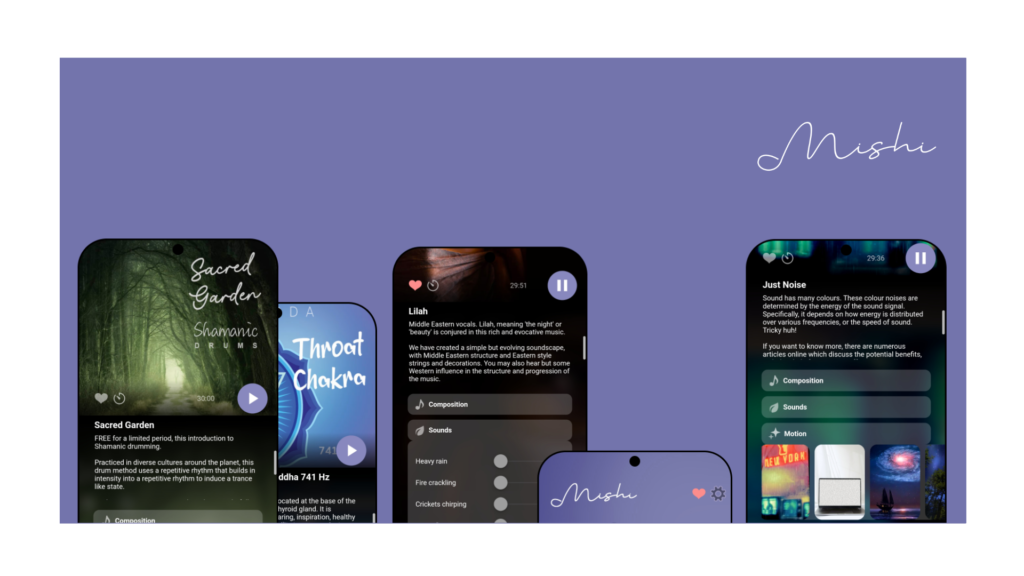
Launch Your App Quickly: The Power of MVPs
Time is of the essence in the fast-paced app market. A faster time-to-market not only gives you a competitive edge but also significantly impacts your budget. Aim to launch your Minimum Viable Product (MVP) within the first three months. This streamlined version of your app should include the core features that deliver your Unique Value Proposition (UVP) and allow you to gather valuable user feedback.
At Wolfpack, we specialize in building MVPs for meditation and wellness apps in as little as 6-8 weeks. Our streamlined development process and expertise with agile methodologies allow us to accelerate your time-to-market, saving you valuable time and resources.
By focusing on a quick MVP launch, you’ll be able to iterate on your app based on real user data and feedback. This iterative approach not only helps you refine your product but also ensures that your budget is being used efficiently, as you can prioritize the development of features that resonate most with your audience.
Monetization Models
- Freemium: Offer a limited set of features for free, then charge for premium content or a subscription to unlock all features and content.
- In-app purchases: Allow users to purchase individual meditations, soundtracks, or courses within the app.
- Ads: While not ideal for a meditation app, you can use ads sparingly to generate revenue. Be sure to choose unobtrusive ad formats that don’t disrupt the user experience.
Marketing and User Acquisition
Promoting your meditation app effectively is crucial for attracting users and building a loyal community. Here are a few strategies to consider:
- Content Marketing: Create valuable content related to meditation and mindfulness, such as blog posts, social media posts, and email newsletters. Share tips, techniques, user stories, and inspirational quotes to attract and engage potential users.
- App Store Optimization (ASO): Optimize your app’s title, description, keywords, screenshots, and videos to improve its visibility and ranking in the app stores. Make sure your app’s listing accurately reflects its features and benefits.
- Influencer Marketing: Partner with mindfulness influencers or bloggers to reach a wider audience and leverage their credibility. Consider offering them free access to your premium features or collaborating on co-created content.
- Social Media Engagement: Build a community around your app by actively engaging with users on social media platforms. Respond to comments, answer questions, and share inspiring content. Encourage user-generated content and create a space where users can connect with each other.
- Paid Advertising: Consider running targeted ads on social media platforms or in-app advertising networks to reach your ideal users.
Pro Tip: We’ve published a comprehensive blog post on Effective Marketing Hacks for App Store and Play Store that delves deeper into ASO, app store advertising, and other proven strategies. Be sure to check it out for a wealth of additional tips and insights!
Which Devices Should You Target?
While launching your meditation app on smartphones (iOS and Android) is a must, consider expanding to other devices to reach a wider audience:
- Tablets (iPads and Android Tablets): Tablets offer a larger screen for immersive meditation sessions and are popular for reading and relaxing.
- Smart TVs: Meditation apps on smart TVs cater to users who prefer guided meditations or relaxing soundscapes as background ambiance while unwinding at home.
- Wearables (Smartwatches): Integration with smartwatches can enable users to track their meditation sessions, access quick meditations, or receive reminders throughout the day.
Remember, each device may require specific design considerations and optimizations to ensure a seamless user experience.
How Much Does It Really Cost to Develop a Meditation App?
The cost of developing a meditation app is as varied as the meditation practices themselves. The price tag can differ significantly based on the features you want to include, the overall complexity of your app, the development team you choose, and where they are located.
To give you a ballpark figure, a basic meditation app with core features like guided meditations, a meditation timer, and basic soundscapes can range from $8,000 to $15,000. This would typically involve a simple design, pre-built components, and a small development team or freelancers.
An advanced meditation app with additional features like personalized recommendations, community features, sleep stories, and more advanced progress tracking can cost anywhere between $15,000 and $50,000. This would likely involve a more customized design, some custom-built components, and a larger development team or agency.
For a high-end, full-featured meditation app with a polished design, advanced personalization, AI-powered coaching, and potentially even wearable integration, you could be looking at a cost of $50,000 or more. This type of app would require a top-tier agency with extensive experience in app development.
Important Note: These are just estimates. The actual cost of your meditation app will depend on your specific requirements and choices. It’s essential to get detailed quotes from multiple developers or agencies to compare costs and ensure you’re getting the best value for your investment.
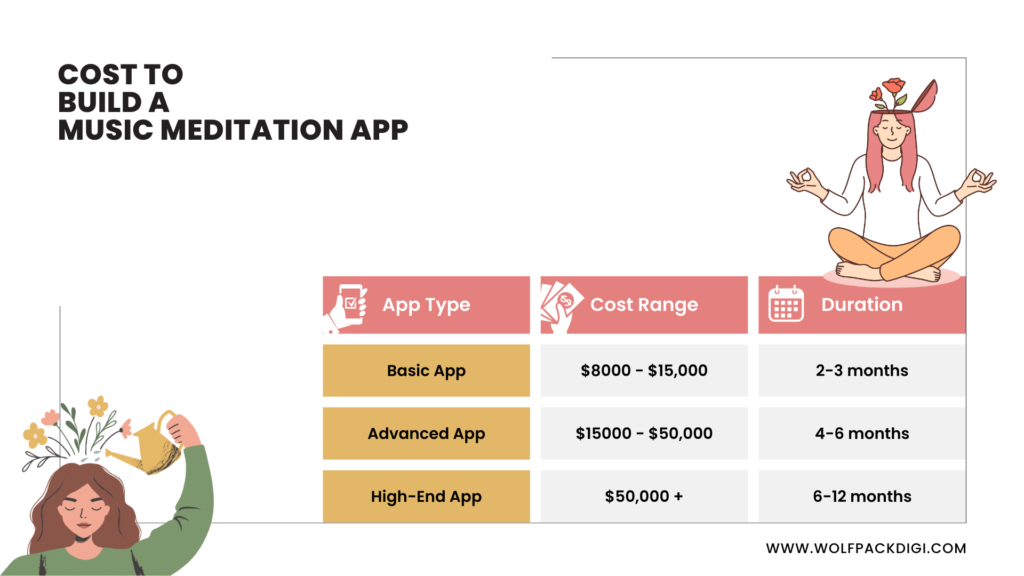
Scaling Up: Transitioning from BaaS to a Custom Backend
While Backend-as-a-Service (BaaS) platforms like Firebase and Supabase offer a cost-effective and quick way to launch your meditation app, they might not be the most scalable or customizable solution in the long run.
As your app grows and you require more complex features, data management, or integrations, you might consider transitioning to a custom backend built with technologies like Node.js, Django (Python), or Ruby on Rails.
Many successful apps, like Instagram and Twitter, initially used BaaS platforms and then migrated to custom backends as they grew. This allowed them to handle their increasing scale and unique requirements more effectively.
Building Your Meditation Oasis
Creating a successful meditation app is a journey that requires careful planning, smart decisions, and a dedication to providing value to your users. By prioritizing the core elements that differentiate your app, making budget-conscious choices, and engaging your community, you can build a thriving meditation oasis that helps people find peace and well-being in their busy lives.
Ready to embark on your meditation app journey?
Wolfpack is here to help you turn your vision into reality. Our experienced team specializes in crafting custom meditation apps that captivate users and deliver results. Whether you’re starting from scratch or looking to enhance an existing app, we’ll work with you every step of the way to create a truly transformative experience.
Contact Wolfpack today to start building your meditation app!
